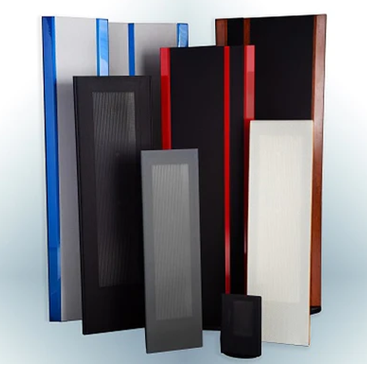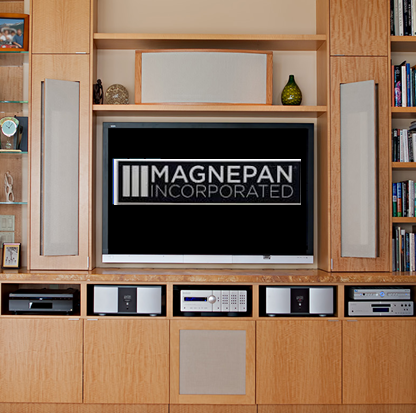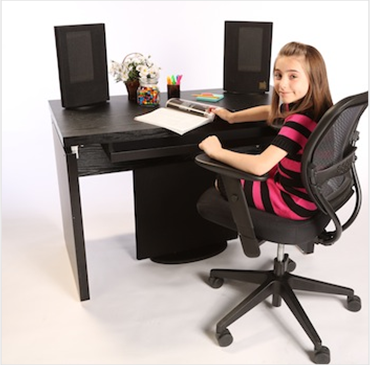Magneplanar 1.7i Instruction Manual
TABLE OF CONTENTS
Introduction
Magnepan urges that you read this instruction manual thoroughly and completely before using your MG1.7i's and recommends reading the accompanying MAGNEPAN INCORPORATED LIMITED 3-YEAR WARRANTY document as well. For questions please contact you local Magnepan Certified Dealership or Magnepan, Inc. at 651-426-1645. You can also visit the website, www.magnepan.com, for additional support .
-
General Description
The MG1.7i's are a pair of 3-way, full-range, Magneplanar loudspeakers. Each section, Mid/bass, Tweeter, and Super Tweeter is compromised of aluminum foil. Often referred to as "quasi-ribbon," the foil is adhered to the Mylar diaphragm which is visible through the front of the fabric cover. The MG1.7i's reproduce sound by introducing an AC signal to the conductor foil on the diaphragm which reacts to the fixed array of magnet strips mounted behind the Mylar. This reaction vibrates the diaphragm projecting sound as a dipole, both forward and backward.
The "i" stands for "improved," and is an important distinction though the MG1.7i's are often referred to as the simply the, "M G one point seven," or even just the, "one sevens."
-
Intended Use
MG1.7i's are intended for used as a part of an audio system or home-theater system.
These speakers should be paired with high-end audio equipment for the most ideal effects. A powerful and/or high-current amplifier(s) is best---certain exceptions apply but generally an amp ought to be able to produce at least 120 watts per channel (RMS) into 4 ohms in order to properly drive the MG1.7i's. Within reason more power and/or higher current is better; there isn't really an upper limit. In addition to the system components, the input signal should also be high-quality. Subpar components and/or input(s) will be sonically evident.
MG1.7i's are only intended to use and storage indoors, within a climate controlled environment, with little or no direct sunlight. Magnepan speakers should not be used or stored outside. They should not be in direct sunlight, nor should they be exposed to excessive humidity or salt spray
-
Carton Contents
- Carton and packaging: DO NOT DISCARD
- One (1) pair MG1.7i 3-way Magneplanar Loudspeakers
- Four (4) T-feet
- Eight (8) feet bolts preinstalled
- Four (4) long feet bolts for tilting, see Fine Tuning, Tilting.
- Eight (8) nylon washer spaces for tilting feature, see Fine Tuning,Tilting
- Two (2) 1 ohm resistors for tweeter attenuation, see Fine Tuning, Tweeter Attenuation
- One (1) Allen wrench
- Two (2) Extra 4amp. 3AG fastblow fuses
- Two (2) Magneplanar self-adhesive emblems
- One (1) instruction manual
- One (1) warranty document
-
Specifications
- Frequency response: 40Hz to 22kHz +/- 3dB
- Sensitivity: 86 dB, 500Hz, 1 meter, 2.83V
- Impedance: 4 Ohms, nominal
- Panel dimensions and weight: 64-1/2" x 19-1/4" x 2" 38lbs
- Carton dimensions and weight: 74" x 23" x 6" 98lbs
- Warranty: Limited 3 years to original purchaser see warranty document
- Shipping Weight: 95 lbs.
Set up
With speakers of this size, assembly may be easier with the help of another person. The only tool required for this process that isn't included is a #2 Philips screwdriver (or similar). Remember to save all of the packaging, including the carton itself.
-
Assembly
- With the carton lying down, face-up, remove T-feet and speakers from the box. Set each speaker panel upright and slide the plastic bag up off the speaker. Remove the literature and hardware kit, as well as the T-feet from their packaging. Collect all packaging within the carton for storage.
- To install the T-feet, start with the speaker panel laying flat face down. It will be easiest with the bottom of the speaker on or near the edge of a raised surface, such a s a table be careful not to put pressure on the face of the speaker--an even and flat surface is best. Unscrew the bolts preinstalled in the speaker, then place the T-foot in position, and re-install the bolts through the T-foot and into the back of the speaker. At this point, with the speaker still lying down, tighten the bolts only snug enough so that the feet are secure but still have some play. Then after both left and right T-feet are attached, set the speaker upright and in the speakers' general listening position. You may want to push down slightly or minorly adjust the T-feet based on the levelness of the surface and/or density of the flooring material. When the ideal alignment has been reached, tighten the bolts completely. Repeat this process for the other panel.
- The self-adhesive Magneplanar emblems may be applied to the speaker wherever is preferred. If you don't have a strong preference, Magnepan suggests top center on the front of the speaker.
-
Connection
- Using the Allen wrench provided, unscrew the set screws within each AMPLIFIER terminal screw on the nameplate such that the set screw is not visible inside of the terminal screw opening.
- Insert either bare speaker wire (up to 10 gauge) or speaker cable terminated with standard banana connectors (or similar ) into each AMP terminal Screw opening. Tighten the set screws in order to ensure a secure connection. Make sure to observe polarity, i.e. + to + and - to -.
- Spade Lug adapters may be purchased from a Magnepan Certified Dealership or from Magnepan directly if using cables terminated with spade lugs.
-
Quick Placement
- Position
-
Speaker Placement
Proper speaker placement and room acoustics can have a greater effect on a music system than upgrading one of the components in the system. Unfortunately, there is no definitive guideline which will cover all possible listening rooms. Some experimentation is required for locating the optimum position. The following are a few general guidelines:
-
Bass Response
Play a CD with repetitive bass. Try the speakers in several possible locations in the room. Begin experimenting with the speakers about 3 feet from the front wall. Try moving the speakers forward or backward in increments of 6 to 12 inches. One position in the room should be noticeably better than others. Also experiment with your listening location to avoid standing waves.
Need more bass?
Most of the area of any full-range Maggie is devoted to bass reproduction. (In the case of the 20.7, 76% of the total radiating area is devoted to bass.) The Magneplanar Bass Panel offers you the flexibility to add bass diaphragm area to fit the needs of your room. From the $600 pair MMG to the 20.7, the Maggie Bass Panel can get the bass/midbass "just right".
-
Left/Right
The 1.7i's are matched pairs and mirror-imaged. The serial number for each speaker in the pair is the same, except for a "1" or "2" following each serial number. As you face the front of the speakers, the speaker with the serial number ending with the "1" after its serial number has the tweeter near the left edge, and the speaker serial number ending with the "2" has the tweeter near the right edge.
-
Stereo Width and Imaging
Once you have located the best position for the speakers and your chair for bass performance, separate the speakers by 50-60% of the distance from your chair to the speakers. For example, if your chair is 10 feet from the speakers, move the speakers 5-6 feet apart. Now, move the speakers apart in increments of 3 or 4 inches at a time, listening carefully at each position. At some point you will start to hear two separate speakers instead of a stage effect or continuous image. When this occurs, your speakers are too far apart. Begin moving the speakers back in small increments until you notice a point at which you achieve one cohesive sound stage.
 Fig. 1
Fig. 2
Fig. 1
Fig. 2
-
Phasing
The Magneplanar 1.7i has superior phase characteristics. We suggest you resist the tendency to place the speakers so they are parallel to the front wall. For optimum phasing, the speakers should angled as shown in Figures 1 or 2.
Depending upon the acoustics of your room, the imaging and sound stage may be better with the tweeters on the inside for listening only in the "sweet spot". For a larger audience and listening further off-axis, try tweeters on the outside. Angle the speakers as shown in Figures 1 or 2.
Once you have located the ideal speaker position, a mark is helpful for quickly replacing the speakers. A small tack, yarn woven into the carpet, or piece of tape can be placed on the carpet so your ideal listening spot can be easily relocated when the speakers (or chair) are moved for cleaning, etc. In the event your ideal listening spot is inconvenient from the standpoint of the room layout and decor, simply slide the speakers wherever they look best. For background listening the speakers can be placed close to the wall and it will make little difference.
-
Room Acoustics
The judicious use of damping material can improve the sound. Acoustical damping can be achieved with household items or wall hangings. A word of caution--when audiophiles discover the effectiveness of damping material, they sometimes overdo it (on the premise that if a little is good, more is better). Before making a permanent change to your room, experiment with the positioning of the damping material. Usually a portion of one or two parallel walls should have some damping. However, it is a trial-and-error process.
An over-damped room will provide very precise imaging, but the sound will seem "dead." An under-damped room may heighten the illusion of being in a concert hall, but the imaging will seem imprecise with all the instruments mixed together. "Hardness" or over-bright sound is usually the result of a room with hard surfaces (glass, hard paneling,etc.). Moderation is the key.
Diffusers are also helpful to improve the acoustics of a room. Contact your Magnepan dealer for more information on the proper use of diffusers.
-
Optional Tweeter Attenuation
There are two principal reasons for needing to attenuate the Magneplanar Quasi-Ribbon Tweeter and Super Tweeter:
- Pop or rock recordings often exhibit a pronounced rise in the treble region.
- The Magneplanar Quasi Ribbon Tweeter is very efficient in its total energy dispersion. If the surrounding walls are exceptionally reflective, the overall perceived acoustical balance will be tipped towards a "hot" high end.
Attenuation is performed through insertion of a resistor in place of the jumper. The pair of 1.2 ohm resistors will attenuate the tweeter 1-2 dB. Other values are available from your Magneplanar dealer.
-
Maintenance
Light vacuuming of the grille cloth is possible.
-
Revised- 2-1-15


